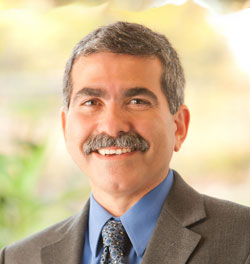Jaw surgery can help sleep apnea patients with failed CPAP compliance

Untreated obstructive sleep apnea (OSA) can lead to serious health issues. It has been linked to high blood pressure, heart rhythm problems, heart attacks, strokes, diabetes control issues, decreased seizure threshold and exacerbation of chronic pain issues.
Continuous positive airway pressure (CPAP) is typically the first line of treatment for people with moderate to severe sleep apnea. “However, several studies show that more than 50 percent of people who use a CPAP appliance do not comply, typically due to a poor fit or discomfort from the mask and other side effects,” says Valmont Desa, DDS, MD, oral and maxillofacial surgeon. Orthognathic jaw surgery (maxillary-mandibular advancement, or MMA) has been successful in helping many of these patients, says Dr. Desa.

The American Academy of Sleep Medicine practice parameters states: “MMA is indicated for surgical treatment of severe obstructive sleep apnea in patients who cannot tolerate or who are unwilling to adhere to positive airway pressure therapy.”
Candidates for the surgery include people with severe sleep apnea (30-plus interruptions per hour), unsuccessful CPAP compliance and underlying jaw abnormality. “We have had success performing this surgery both on people with or without an underlying jaw abnormality,” says Dr. Desa. Dr. Desa and oral and maxillofacial surgeon Jason Untrauer, DDS, MD, perform about 100 orthognathic surgeries a year, most of them for correction of developmental jaw abnormalities.
Surgery involves performing a LeFort osteotomy (upper jaw surgery) and a sagittal split osteotomy (lower jaw surgery) to bring both the jaws forward and align them properly. “The base of the tongue is usually the level of obstruction,” notes Dr. Desa. “By bringing the upper and lower jaw forward, this usually resolves the obstruction.”
The procedure is similar to surgery used to correct an overbite. All incisions are made in the mouth, so there are no visible scars. The surgeon makes cuts in the jawbones and moves them into the correct position. Once the jaws are properly aligned, screws and bone plates secure the bones into their new position. The jaws are not wired shut. Drs. Desa and Untrauer use 3-D orthognathic and airway planning software to ensure precise repositioning of the jaws. The three- to four-hour surgery requires an overnight stay in the hospital and soft foods for four weeks. Complete recovery at home typically takes 10 to 14 days.
“We’ve seen greater than 90 percent success rate in the patients for whom we have performed the surgery,” says Dr. Desa. “In patients that get partial improvement, CPAP pressures usually can be lowered, resulting in better CPAP compliance.”
“This procedure can help patients regain quality of life,” says Dr. Desa. “They can get deep sleep again, report dreaming, have less fatigue and more energy. It also reduces their risk for heart disease, stroke and hypertension.”




